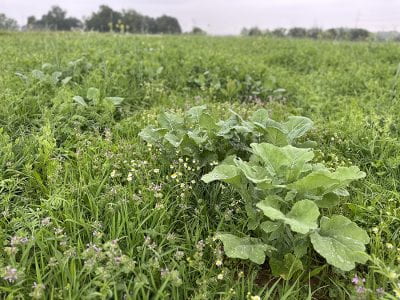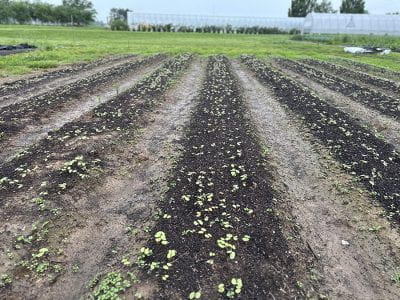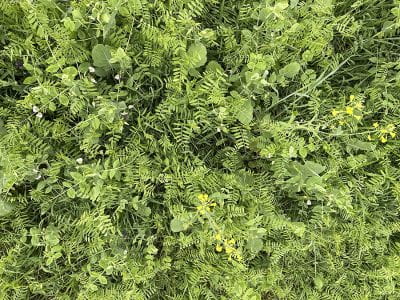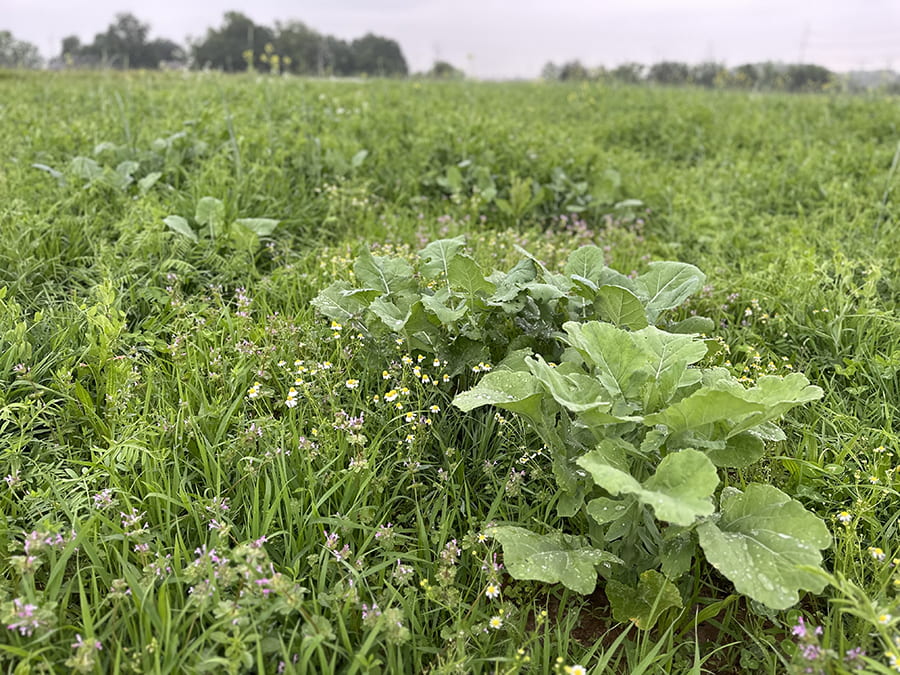Cover crops provide many functions beyond weed control on a farm. They build soil health, improve fertility, provide habitat for beneficial insects, and can help break pest cycles. In this blog post we will provide a brief overview of the benefits of cover crops and how you can start incorporating cover crops into your farm or garden.

[Figure 1. A cool-season cover crop of rye, barley, winter peas, rapeseed, and hairy vetch growing at the CAFF farm in mid-May.]
What are cover crops?
Cover crops include a wide variety of plant species that are not grown for sale, but instead are grown to benefit the soil. Green manure is another term used for cover crops, especially those destined to be mowed down and incorporated back into the soil. Certain cash crop species like wheat, rye, or cowpeas can be grown as cover crops if the goal is not the production of grain or seed for harvest, but the goal is the production of the plant biomass itself, which is usually mowed down before the harvestable crop would be mature.
Common cool-season cover crops for the mid-South include winter wheat, winter rye, oats, mustard, vetch, clover, and peas. Common warm-season cover crops include sorghum-sudangrass, millet, buckwheat, cowpeas, soybeans, and sunnhemp.
How do cover crops suppress weeds?
Cover crops are planted at a high density and suppress weeds by out-competing them for sunlight and nutrients. Some cover crop species are more competitive than others, making it beneficial to plant a cover crop blend. Grass species like winter rye and sorghum-sudangrass are very fast-growing and can easily out-compete other weeds. Certain cover crop species can also compete with weeds chemically (called allelopathy), either by exuding chemicals through their roots or releasing chemicals when they decompose in the soil, which inhibits the growth or germination of weed seeds.
How do cover crops build soil health?
Cover crops build soil health by feeding soil microbes through their roots when they are growing and then feeding the soil microbes with their biomass after they are mowed down and incorporated into the soil. Carbon is the main element that feeds the soil food web and growing cover crops can be seen as converting energy from the sun into soil carbon. Cover crops convert solar energy into sugars (made from carbon), which they exude through their roots to feed soil microbes. The also use solar energy to grow their biomass, made up of carbon, which then gets incorporated into the soil after they are mowed down.
More carbon fed into the soil means more life in the soil, which will contribute to better soil structure, better water-holding capacity, better nutrient-holding capacity, suppression of soil-borne diseases and better soil tilth. Growing cover crops is analogous to growing your own compost, except the cover crops get composted right there in the soil.
How do cover crops improve soil fertility?
All cover crops will improve soil health and the cycling of nutrients, which will make it easier for cash crops to access the nutrients that are already present in the soil. But certain legume cover crop species can actually add nitrogen to the soil through biological nitrogen fixation. Legumes like clover, peas, and beans have a unique relationship with rhizobia bacterial that form nodules in the plant roots and “fix” nitrogen from the air into forms that plants can use. A healthy stand of legume cover crops species can fix between 50 to 150 pounds of nitrogen per acre, which goes a long way to providing for the nitrogen requirements of a cash crop. The only catch is that this nitrogen is contained within the plant biomass, so the cover crop must be incorporated into the soil for that nitrogen to be made available to a subsequent crop.

[Figure 2. A cool-season cover crop mix was seeded in the drive-rows between plasticulture beds at the CAFF Farm.]
How to fit cover crops into a crop rotation
Cover crops can do much to benefit your farm or garden, but now let’s consider about how they can best fit into your system. There are a few ways to approach this. One strategy is to plan a multi-year crop rotation where you decide to plant a field or block in cover crops every 2, 3, or 4 years. Even if a field is only being planted in cover crops once every four years, it will still make a difference regarding weed suppression, breaking pest cycles, and building soil fertility. In this example you could decide that every fourth year a field block would be planted to summer cover crops followed by winter cover crops before going back into a cash crops. At the CAFF Farm we currently have a 3-year rotation in our large-scale fields where one of our three field blocks gets grown in a cover crop every year. In our large-scale fields that are in production we also plant the drive-rows and field margins to cover crops to control soil erosion and suppress weeds.
Another approach to is to look at how cover crops can fit into your crop rotation as it stands. Some cover crops like buckwheat only need 30-45 days, so they can easily be grown during the season between a spring and fall vegetable crop for example. One consideration with fitting in cover crops between cash crops is that you must allow 2-3 weeks after incorporation before planting your next crop. Going back to the buckwheat example, a minimum time window of 2 months would be needed between cash crops. But you may find that you have windows of opportunity in your current crop rotation to fit in short-season cover crops.

[Figure 3. A short-season buckwheat cover crop was planted on raised beds at the CAFF Farm.]
Winter cover crops are a good place to start if you do not grow many winter crops on your farm already. Most winter cover crops in this region need to be planted in mid-September and can be killed in mid-April. If this is a time period where some of your fields lay fallow, it would be a great opportunity to use that time to start building soil fertility and suppressing weeds with cover crops. Excellent winter cover crops for the Mid-South include winter rye, crimson clover, hairy vetch, tillage radish, and Austrian winter pea.
How to terminate and incorporate cover crops
A important consideration with growing cover crops is knowing what to do with the biomass. There are several options depending on your goals. It is most common for farmers to mow down a cover crop with a brush hog or flail mower and then incorporate the biomass into the soil with a tiller or spader. As mentioned above, you will need to allow 2-3 weeks for that cover crop residue to break down in the soil before planting your next crop. Allow at least three weeks for crops that will be direct-seeded so that the decomposing cover crop residue does not inhibit seed germination.
A no-till alternative to incorporating the cover crop biomass is to leave it on the soil surface as a mulch. There are a few ways to do this – either rolling down the cover crop with a roller-crimper or cutting it down with a sickle-bar mower. Large-seeded crops like squash or corn can be directly seeded and grow through the reside or a crop like tomato could be transplanted with minimal soil disturbance. In a no-till system such as this ensuring your cover crop produces a significant amount of biomass very important to guarantee adequate weed control.

[Figure 4. This cool-season cover crop mix includes cereal rye, winter barley, Austrian winter peas, hairy vetch, and rapeseed.]
Conclusion
Growing cover crops on your farm or in your garden is a very effective means of building soil health, improving fertility, breaking pest cycles, and suppressing weeds. How and when you fit cover crops into your system depends a lot on your crop mix, your scale, and the equipment you have access to. You will need to find space in your crop rotation plan to fit in cover crops and you will need to think through how you will terminate the cover crop and deal with the biomass. Growing cover crops does take time and attention, but you will find the rewards to be numerous.
If you would like to explore this topic further, the SARE publication “Managing Cover Crops Profitably” (which you can download for free from https://www.sare.org/resources/managing-cover-crops-profitably-3rd-edition/), is a great resource for considering different cover crop species, options for incorporating cover crops into your crop rotation, and no-till strategies.


Recent Comments